While it has understandably not received much, if any, media attention, the North Atlantic Ocean has been rapidly cooling since the mid-2000s, or for more than 10 years now. The longer the cooling trend continues — and scientists are projecting more cooling for the coming decades — the more difficult it will be to ignore. The North Atlantic Ocean is, after all, a key trend-setter for hemispheric- and perhaps even global-scale climate changes.
In their new paper, for example, Reynolds and colleagues (2017) point out that natural fluctuations in heat transport initiated by the Atlantic Meridional Overturning Circulation (AMOC) are “directly linked” to precipitation and warming/cooling temperature trends in Africa, Brazil, North America, and Europe. Not only that, but the authors explain that a centennial-scale reduction in surface heat transport (AMOC) can explain the dramatic reduction in surface temperatures from the warmth of the Medieval Warm Period to the frigid Little Ice Age, which, of course, could imply that centennial-scale increases in surface heat transport could explain warming periods.
Reynolds et al., 2017 Evidence derived from instrumental observations suggest that Atlantic variability, associated with changes in SSTs and fluctuations in the strength of the Atlantic Meridional Overturning Circulation (AMOC), is directly linked with broader scale climate variability, including Brazilian and Sahel precipitation (Folland et al., 1986 and Folland et al., 2001), Atlantic hurricanes and storm tracks (Goldenberg et al., 2001 and Emanuel, 2005), and North American and European temperatures (Sutton and Hodson, 2005, Knight et al., 2006 and Mann et al., 2009). Furthermore, evidence derived from palaeoceanographic records suggests that a reduction in the meridional heat transport through the surface components of the AMOC was in part responsible for the reductions in temperatures associated with the Medieval Climate Anomaly (MCA; 1000–1450) to Little Ice Age (LIA; 1450–1850) transition (Lund et al., 2006, Trouet et al., 2009, Trouet et al., 2012, Wanamaker et al., 2012 and Moffa-Sánchez et al., 2014).
Examining the Reynolds et al. (2017) graph of North Atlantic sea surface temperatures since the early 1800s, we notice that temperatures (shown to have declined by about -0.45 °C since 2005) are colder now than they were in the 1940s and 1950s, and that even the early 1800s had warmer temperatures than now.
Serykh (2016) points out that the warming enjoyed across Europe and Asia between the 1970s and late 1990s may have been associated with natural decadal-scale oscillations in heat transport. Similar to Reynolds et al. (2017), Serykh’s graph of ocean heat content reveals no net warming in the last 60 years.
Serykh, 2016 A dipole structure of inter-decadal variations in the heat content of the ocean and heat fluxes from the ocean to the atmosphere has been detected in the North Atlantic. The following fact deserves special attention: the cyclonic and anti-cyclonic atmospheric circulation anomalies, as well as the decrease and increase in the ocean heat content, take place concurrently and quasi-synchronously in the Iceland minimum and Azores maximum regions. Owing to this, the western heat transport anomalies along the 50th parallel increase or decrease the transport of heat from the Atlantic Ocean to the Euro-Asian continent, and the climate in Europe and Siberia becomes more marine or more continental. The very fast climate warming of the Euro-Asian continent that began in the 1970s may be associated with the enhanced heat transport from the North Atlantic in this period. This is evident from the fields and time series obtained in the present paper. The hiatus of this warming after 1999 may be due to the decreased heat transfer from the North Atlantic Ocean to the Eurasian territory.
Dramatic Cooling In the North Atlantic (Affecting Global Climate) Linked To Natural Variability, Not Human Influence
Scientists first began highlighting the North Atlantic cooling trend a few years ago. Hermanson et al. (2014), for example, pointed out that the AMOC modulates the water temperatures in the North Atlantic by driving the transport of warmer (cooler) ocean water on decadal scales. Using data that extended through 2012, they (correctly) forecast the cooling trend that had begun in the mid-2000s would continue. It has.
Hermanson et al., 2014 The observed 5 year mean temperature averaged over the upper 500 m of the SPG [Subpolar Gyre, North Atlantic Ocean] [shows] a marked cooling in the late 1960s followed by a period with below average temperatures, and a warming in the 1990s followed by a period with above average temperatures. … The forecasts that were initialized between 2008 and 2012 (crosses) all show a general trend for further decreases in temperature, continuing the observed [cooling] trend. The 2012 forecast spread suggests that the chance of the observed warm SPG mean temperature anomaly of 2003–2007 (0.53) occurring again in 2013–2017 is less than 6%.
To gain further confidence in this forecast we examine the physical mechanisms that control SPG [North Atlantic Ocean] temperatures. Previous studies showed that the 1990s SPG warming was driven by increased convergence of ocean heat transport resulting from an increase in the AMOC, and the 1960s cooling was driven by reduced ocean heat transport convergence following a reduced AMOC. The hindcasts show changes in ocean heat transport convergence, consistent with these earlier events. The forecasts show a continued decrease in ocean heat transport convergence, consistent with a cooling SPG [Subpolar Gyre, North Atlantic Ocean].
A year ago, Robson et al. (2016) published a paper in Nature explaining that the previous warming trend (1995-2005) had “reversed” to a -0.45 °C cooling trend since 2005 (through 2015), and, like Hermanson et al. (2014) and Reynolds et al. (2017), they attributed both the 1995-2005 warming trend and the current cooling trend to the vagaries of the Atlantic Meridional Overturning Circulation, even pointing out that the trends are not consistent with an anthropogenic influence.
Robson et al., 2016 In the mid-1990s the North Atlantic subpolar gyre warmed rapidly, which had important climate impacts such as increased hurricane numbers and changes to rainfall over Africa, Europe and North America. Evidence suggests that the warming was largely due to a strengthening of the ocean circulation, particularly the Atlantic Meridional Overturning Circulation. Since the mid-1990s direct and indirect measurements have suggested a decline in the strength of the ocean circulation, which is expected to lead to a reduction in northward heat transport. Here we show that since 2005 a large volume of the upper North Atlantic Ocean has cooled significantly by approximately 0.45 °C or 1.5 × 1022 J, reversing the previous warming trend. … The observed upper ocean cooling since 2005 is not consistent with the hypothesis that anthropogenic aerosols directly drive Atlantic temperatures.
As the introductory graph of the North Atlantic trend shows above, Duchez and colleagues (2016) report that today’s temperatures are colder than they were in the 1950s — up to 2 °C colder than average — and the “most extreme in the modern record [1948-2015].”.
Duchez et al., 2016 [C]old ocean temperatures were the most extreme in the modern record [since 1948] over much of the mid-high latitude North-East Atlantic. … we consider the exceptionally cold ocean surface anomaly that was already in place prior to the onset of the 2015 heat wave. The SST anomaly field for June 2015 shows temperatures up to 2 °C colder than normal over much of the sub-polar gyre with values that are the coldest observed for this month of the year in the period 1948–2015 indicated by stippling. The cause of this cold anomaly has been the subject of widespread interest in the media, we now show for the first time that it can be attributed to a combination of air–sea heat loss from late 2014 through to spring 2015 and a re-emergent sub-surface ocean heat content [cold] anomaly that developed in preceding years.
Chafik et al. (2016) connect the warming-cooling-warming-cooling oscillatory patterns in the North Atlantic to the natural atmospheric forcing associated with the North Atlantic Oscillation (NAO) (which is symbiotically connected to the AMOC), and they also highlight the recent cooling trend in their graph (ending in 2012). They further agree with other scientists that the North Atlantic region is “important for global mean temperature warming,” meaning that what happens in the North Atlantic may have broad implications for climate.
Chafik et al., 2016 The multidecadal variability of the North Atlantic Ocean has a strong signal in the sea surface temperature with many global climate linkages [Enfield et al., 2001; Knight et al., 2006]. An even stronger multidecadal signal can be found in the subpolar temperatures and salinities, where the Atlantic Water inflow variations constitute an essential part in the variability [Hátún et al., 2005; Häkkinen et al., 2011a; Reverdin, 2010]. The atmospheric forcing in the subpolar North Atlantic Ocean is dominated by the variability of the North Atlantic Oscillation (NAO), i.e., the leading mode of atmospheric variability in the North Atlantic sector, which modulates the atmosphere-ocean momentum and heat exchanges on a range of temporal scales. The subpolar ocean variability thus appears to be tightly connected to atmospheric forcing and associated basin-scale circulation changes, which together force the subpolar ocean properties toward extremes [Lozier et al., 2008, 2010], either to warm-saline or cold-fresh conditions on multidecadal scales. These regime changes have recently been argued to be important for global mean surface temperature warming acceleration and hiatus [Chen and Tung, 2014; Drijfhout et al., 2014].
Koenigk and Brodeau (2016) point out that Arctic sea ice area and volume changes (decline) in the last 30 years are “dominated by” the natural variability in heat transport (AMOC), and that a cooling trend may be in the works through 2030.
Koenigk and Brodeau, 2016 Decadal variations of Arctic sea ice extent and ice volume are of the same order of magnitude as the observed ice extent reductions in the last 30 years and are dominated by the variability of the ocean heat transports through the Barents Sea Opening and the Bering Strait. Despite a general warming of mid and high northern latitudes, a substantial cooling is found in the subpolar gyre of the North Atlantic under year-2015 and year-2030 conditions. This cooling is related to a strong reduction in the AMOC, itself due to reduced deep water formation in the Labrador Sea.
Still more scientists — Barcikowska et al. (2016) — observe a North Atlantic/tropical Pacific cooling-warming-cooling trend that may presage global temperature implications (cooling) for the coming decade(s).
Barcikowska et al., 2016 If the observations-based component of variability originates from internal climate processes, as found in the model, the recently observed (1970s-2000s) North Atlantic warming and eastern tropical Pacific cooling might presage an ongoing transition to a cold North Atlantic phase with possible implications for near-term global temperature evolution.
The North Atlantic Is Much Colder Now Than When CO2 Levels Were Much Lower
Because it is important to consider context, it should be pointed out that the 1995-2005 warming that occurred in the North Atlantic was not only well within the range of AMOC-driven natural variability, the relative warmth in that decade was still comparatively cold when considering the long-term temperatures for the North Atlantic region. In fact, scientists have recently determined that the modern temperatures for the North Atlantic are still among the coldest of the last several thousand years — even the last few hundred.
The conspicuous lack of a net warming trend is significant because it is often claimed that anthropogenic CO2 emissions are the predominant cause of warming global ocean waters. But there is no correlation between net ocean heat or surface temperature changes in the North Atlantic and the dramatic rise in anthropogenic CO2 emissions since the 1950s. Or since the 1850s. Or since Medieval times. Or since the Holocene began.
The Last 165 Years…
The Last 1,200 Years…
The Last 10,000 Years….
The Ultimate Cause Of Oceanic Temperature Shifts, Climate Change: Solar Variability
In their Nature paper entitled “Solar forcing of North Atlantic surface temperature and salinity over the past millennium”, Moffa-Sánchez et al. (2014) point out that North Atlantic sea surface temperatures have risen and fallen by as much as 3.5°C within only multi-decadal- to century-long time periods several times during the last millennium. This magnitude and rapidity of oceanic change — which occurred without any significant changes in atmospheric CO2 — is obviously far more pronounced than the tenths-of-a-degree net change (if that) over the last 100 years in the North Atlantic. It is also wholly inconsistent with the climate modeled presumption that natural variability in ocean temperatures is so small, and the anthropogenic forcing of recent decades is so dominant, that natural variability can be clearly separated from anthropogenic forcing.
Our results reveal abrupt multidecadal to centennial shifts in the temperature and salinity of the NAC [North Atlantic Current] waters of ∼3.5 °C and ∼1.2 °C, respectively, during the past millennium.
Indeed, the massive increase in anthropogenic CO2 emissions since 1950 have occurred during the same period of time that the North Atlantic has undergone essentially zero net temperature changes (as the papers and graphs above illustrate), strongly suggesting that anthropogenic CO2 climate forcing has exerted little to no influence on North Atlantic water temperatures. This would also effectively rule out a significant anthropogenic influence on hemispheric- and even global-scale climate changes considering the North Atlantic’s seminal role as a climatic pace-setter.
Not only that, but as Smeed et al. (2014) affirm, the abrupt change (reduction) in the AMOC heat transport since the mid-2000s is far more pronounced in magnitude (ten times greater) and rapid than climate models have projected to accrue due to anthropogenic forcing, which also strongly suggests the AMOC (and oceanic heat transport in general) is not modulated by CO2 emissions.
Smeed et al, 2014 Model simulations predict a decrease of the AMOC in the 21st century in response to increasing greenhouse gases of the order of one half a Sverdrup per decade (IPCC, 2007). Our observations indicate that the actual change over the last decade is much greater. The magnitude of the observed changes suggests that they are a part of a cyclical change rather than being directly linked to the projected anthropogenic AMOC decrease. … We have shown that there was a slowdown in the AMOC transport between 2004 and 2012 amounting to an average of −0.54 Sv yr−1 (95 % c.i. −0.08 to −0.99 Sv yr−1 ) at 26◦ N, and that this was primarily due to a strengthening of the southward flow in the upper 1100 m and a reduction of the southward transport of NADW below 3000 m. This trend is an order of magnitude larger than that predicted by climate models associated with global climate change scenarios, suggesting that this decrease represents decadal variability in the AMOC system rather than a response to climate change.
So if anthropogenic CO2 emissions are not the North Atlantic’s climate control knob, what mechanism does modulate the AMOC, which, in turn, leads to abrupt multi-decadal- to centennial-scale warming and cooling periods? Returning to Moffa-Sánchez et al. (2014), we find that there has been a robust correlation between the undulations in the AMOC and the variability in solar irradiance for the last 1,000 years.
Moffa-Sánchez et al., 2014 There were several centennial-scale fluctuations in the climate and oceanography of the North Atlantic region over the past 1,000 years, including a period of relative cooling from about AD 1450 to 1850 known as the Little Ice Age. These variations may be linked to changes in solar irradiance, amplified through feedbacks including the Atlantic meridional overturning circulation. … The reconstructed centennial-scale variations in hydrography correlate with variability in total solar irradiance. We find a similar correlation in a simulation of climate over the past 1,000 years. [L]ow solar irradiance promotes the development of frequent and persistent atmospheric blocking events, in which a quasi-stationary high-pressure system in the eastern North Atlantic modifies the flow of the westerly winds. … Our results reveal abrupt multidecadal to centennial shifts in the temperature and salinity of the NAC [North Atlantic Current] waters of ∼3.5 °C and ∼1.2 °C, respectively, during the past millennium. The magnitude of the hydrographic variability is substantial and comparable to that recorded in a lower resolution record spanning the present interglacial from a nearby site, which highlights the similarities in the ocean variability on a diverse range of timescales. The timing of the hydrographic shifts shows a strong correlation with total solar irradiance (TSI) variability. Periods of solar minima (maxima) generally correspond to cold and fresh (warm and salty) conditions in the NAC.
Recently published scientific papers have documented that the Modern Grand Maximum of very high solar activity ended in the early 21st century, and this has, in turn, led to many predictions of global-scale cooling in the coming decades (Abdussamatov, 2016, Torres and Guzmán, 2016, Yndestad and Solheim, 2016, Mörner, 2015, Evans, 2016). The recently observed trends in the North Atlantic ostensibly support these projections of near-term solar- and AMOC-forced multi-decadal cooling, as they are in phase with the dramatic decline in North Atlantic heat content and surface temperatures since the mid-2000s documented above. If historical trends repeat, and if the North Atlantic continues to act as a harbinger of what is to come climatically, we may be on the cusp of cold period reminiscent of yet another Little Ice Age – the 19th in the last 7,500 years.
For the sake of humanity and the rest of the biosphere, let’s hope these near-term global cooling projections are inaccurate, as warmth is much preferred to cooling.
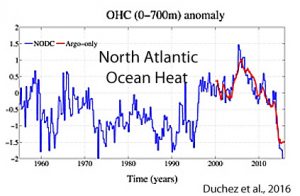
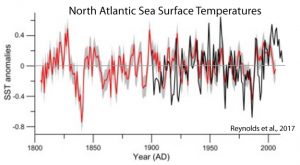
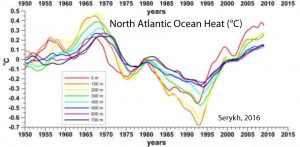
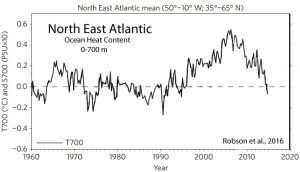
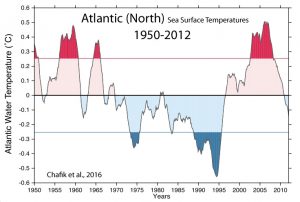
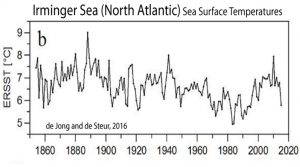
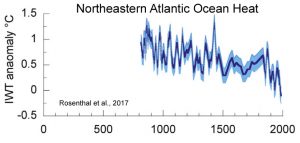
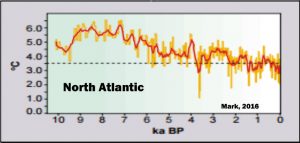





Coolng oceans, natural variation, successful predictions of cooling, possible Little Ice Age – Pierre, I hope your vaccinations are up to date because sod will be slavering at the mouth as he rushes to denounce this science.
Incidentally if temperature of sea water influences the melting of ice
https://soundwaves.usgs.gov/2001/07/glacierbaymap.gif
May be of interest. It seems melting didn’t accord with the ‘settled science’.
[…] Full post […]
Thank you, Pierre for the post.
I recall Joe Bastardi pointed out the forecast of the AMOC going negative on one of his free Saturday, Weather Bell webcasts. He noted, that the North Eastern Atlantic would cool more. As a result, warmer water may pile up on the U.S. eastern coast. As a result, hurricanes could rise to the rate seen in the 1955 through 1965 period. For emphasis, I must state: he did not raise this to the level of a forecast.
Second, and unrelated to the above, Cod migrated off the Grand Banks and apparently moved east. The fishing industry took an enormous hit. Of course, Global Warming was blamed. If the Cod’s smaller prey move west and the Cod follow, warmist heads will explode.
Again, thanks for your great blog.
Thanks! but do thank Kenneth Richard for this one.
I do one better.
Thank you both!
All true but part of this broader scenario:
http://joannenova.com.au/2015/01/is-the-sun-driving-ozone-and-changing-the-climate/
To me, the current Temperature looks like at best tied with nearly 10 other data points. So why would you worry about it?
Interesting! SOD accepts that we are back to 1960 heat content!
Now isn’t that weird! AS IF CO2 made no difference at all!
Of course, this time it’s not a small blip…
Kenneth –
Great stuff indeed.
By the way, where do you get YOUR energy from? – hope it’s renewable..
👌
Not 💨
El niño is gone; the AMO is negative, solar activity is down, now this…
I shudder to think of how all these events will impact the land masses once avalanche of them let’s go.
Thank you, Pierre.
“El niño is gone; the AMO is negative, solar activity is down, now this…
I shudder to think of how all these events will impact the land masses once avalanche of them let’s go.”
Could you please explain to me, what you expect?
At worst, these cyclic changes could lead to low temperatures like in the middle of last century. What would the problem be? What would be alarming about that?
http://www.drroyspencer.com/wp-content/uploads/UAH_LT_1979_thru_December_2016_v6.jpg
On the other hand, the real risk is a further increase of temperature from the current high. And the real risk would be a permanent change, caused by a physical reason (change of CO2 in the atmosphere). Such a change would NOT be cyclical (on human scale).
Can t you see the difference?
“Can t you see the difference?” – sod, propagandist in training
You are pushing the logical fallacy of a “false dilemma,” aka a “false dichotomy.”
You present us with a choice between a harmless cooler world (it is not) and a dangerous warmer world (it is not).
You blame elevated CO2 on humans, when that is in no way established.
You also blame the warming on CO2, when throughout earth’s entire history that has never been the case. If it wasn’t then, it isn’t now, regardless of the source of the CO2.
Reducing CO2 if we could (we can’t) will destroy world economies and dramatically increase human suffering (already has), and will do nothing to either reduce C02 or temperatures. Doing what you advocate only brings harm.
You just regurgitate the same tired lies faux “greenies” have been telling for years. They are no less untrue now than they were when they were first told.
So, yes, I can “see the difference” between you and someone who tells the truth. And that difference is enormous.
“the real risk is a further increase of temperature from the current high”
Wrong again , sop
The current temperature is only a tiny bump out of the COLDEST period in the current interglacial.
As you are not writing from Siberia, I assume you choose to live somewhere warmer, and are probably inside now with heating driven by coal or gas powered electricity.
So long as the temperature only drops to the lows of the 1970s there will only be a slight loss of food production, if it drops much lower food will become an issue if crops are destroyed by frosts etc.
From where the world’s current temperature is….
Colder is NOT good.
Warmer is highly beneficial.
[…] It is a bit technical but I post it for general interest and further discussion. North Atlantic Cooling Has Plunged Below 1950s (And 1800s) Levels – And Scientists Project Mor… […]
When it is hot, it is climate, when it is cool it is weather.
This, for SOD: The old saw goes that if 97% of leading doctors told you that you had a life-threatening cancer that could be operated on, you’d believe them and accept their diagnosis.
Now, my point to SOD is, if you were the one facing the operation (which could be seven hours for a Whipple – look it up) and 97% of Foe, GreenPiss, WWtF and Mann et al said that it would be perfectly alright to operate with power and light supplied from a wind turbine, you’d go for it, right?
[…] 3) North Atlantic Ocean Cooling Rapidly NoTricksZone, 5 January 2017 […]
“Serykh (2016) points out that the warming enjoyed across Europe and Asia between the 1970s and late 1990s ….”
“warming enjoyed across Europe” ??
Didn’t this warming induce all sorts of insanity in half the population and especially in Government and media circles potentially resulting in economic collapse??
“Enjoyed” ??
Yes, plants, animals, and humans enjoy warmer climates. Do you have evidence to suggest they don’t?
http://www.sciencedaily.com/releases/2015/05/150520193831.htm
Cold weather kills 20 times as many people as hot weather, according to an international study analyzing over 74 million deaths in 384 locations across 13 countries
http://www.telegraph.co.uk/news/weather/11382808/Winter-death-toll-to-exceed-40000.html
The cold weather death toll this winter is expected to top 40,000, the highest number for 15 years. The rate soared by 33 per cent in the week up until January 16, when there were almost 15,000 deaths, as the bitter cold snap took hold.
Rosco 7. January 2017 at 10:57 PM | Permalink | Reply
“Didn’t this warming induce all sorts of insanity in half the population and especially in Government and media circles potentially resulting in economic collapse??”
I’ve been in Italy many times and I never have seen an Italian go insane from the fact that it’s warm in summer.
It is not the warming that induces madness but a concerted campaign of cultural marxism since the 1960ies; initiated by the CIA-funded Frankfurt School. (Adorno and Horckheimer were relocated to Frankfurt with the task of “denazifying” Germany, with american funding).
The current extremes brought forth by this campaign of dumbing down the West to an animal-like state are the US SJW’s (well German liberal arts have been like that for a long time as well). (Frankfirt School cofounder Marcuse stayed in USA to accomplish the destruction there.)
Great post Kenneth – well played.
Pierre – hosting a cool site (pun intended).
Harry Passfield excellent rejoinder to the 97% doctor analogy.
It would appear that current and ongoing attempts to “Save the Planet” by imposing intolerable energy and economic costs on millions of people to combat climate change will either succeed in their stated goal of cooling the planet or they will fail; in either case economic and even existential catastrophe will hit millions of the poorest people on the planet. The leaders of the World must be made to lead by example, or face the righteous wrath of their intended victims.
The advocates of these policies may or not be Friends of the Earth, but are most certainly NOT friends of Humanity. Small wonder that ever increasing coercion and subterfuge are to be deployed to ensure that the turkeys of the world do not discover the meaning of Christmas, and turn on their would-be oppressors.
The true mentors of the would-be saviours of the Planet are not the data from climate studies but the Grand Inquisitor depicted by Dostoyevsky nearly 150 years ago, who promise Bread and Safety n exchange of a surrender of Liberty, and deliver none of the above.
The great lie is that all, except for a self-serving elite, must live and die by the zero sum game.The resources available to an enterprising Humanity. The solar system has enough energy and available resources to support an expansion of human assets and, in time, people and so render the zerosum game irrelevant.
The future lies not in regultions or coercive oppression, but in the emerging technology of “New Space”.
It would appear that current and ongoing attempts to “Save the Planet” by imposing intolerable energy and economic costs on millions of people to combat climate change will either succeed in their stated goal of cooling the planet or they will fail; in either case economic and even existential catastrophe will hit millions of the poorest people on the planet. The leaders of the World must be made to lead by example, or face the righteous wrath of their intended victims.
The advocates of these policies may or not be friends of the Earth, but are most certainly NOT friends of Humanity. Small wonder that ever-increasing coercion and subterfuge are to be deployed to ensure that the turkeys of the world do not discover the meaning of Christmas, and turn on their would-be oppressors.
The true mentors of the would-be saviours of the Planet are not the data from climate studies but the Grand Inquisitor depicted by Dostoyevsky nearly 150 years ago, who promise Bread and Safety n exchange of a surrender of Liberty, and deliver none of the above.
The great lie is that all, except for a self-serving elite, must live and die by the zero sum game.The resources available to an enterprising Humanity are far greater than is supposed. The solar system has enough energy and available resources to support an expansion of human assets and, in time, people and so render the zero sum game irrelevant.
A more positive future lies not in overbearing regulations, punitive taxation, or coercive oppression, but in the emerging technologies of “New Space”.These may not succeed- it is not without risk- but the alternative is a set of futures in which the development and prospects for our descendants are degeneration and possible extinction within a historically short period. Throwing the baby out with the bathwater is a real risk. The Human Mind and its potential both on and off the Earth is the fruit of an embryonic self aware Universe, and not to be discarded lightly